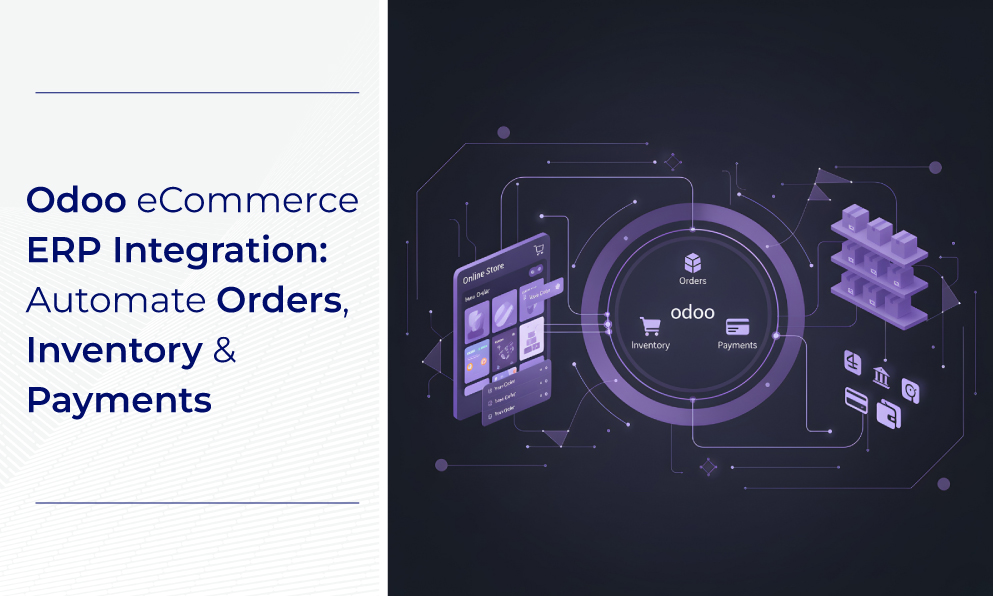Odoo ERP: Unified Platform for Operational Excellence
Odoo ERP delivers a comprehensive solution that addresses a fundamental business challenge: operational fragmentation across departments and systems. By integrating finance, human resources, manufacturing, inventory management, and customer relationship management into a single unified platform, Odoo eliminates the inefficiencies that arise from disconnected software and manual processes.
What Odoo addresses:
- Data inconsistencies across departmental systems
- Redundant data entry requirements consuming valuable time
- Version control difficulties with spreadsheet-based workflows
- Communication delays that impede cross-functional coordination
Measurable organizational impact:
- Enhanced financial reporting accuracy supporting better decision-making
- Accelerated reporting cycles enabling faster strategic responses
- Improved compliance documentation reducing organizational risk
- Reallocation of skilled professionals from reconciliation to strategic initiatives
Research examining ERP implementation in micro, small, and medium enterprises confirms that integrated systems substantially reduce operational inefficiencies, including data duplication, communication breakdowns, and delayed decision-making processes (Setiawan, Siswanto & Sugiarto, 2024).
At BJIT, our implementation experience across Japan, Europe, and Bangladesh has demonstrated consistent, measurable improvements as organizations deploy Odoo's integrated architecture. Odoo represents a proven platform for operational transformation.
Schedule a consultation with BJIT to explore implementation possibilities for your organization.
Odoo's Centralized Data Architecture: Single Source of Truth
How Odoo Eliminates Data Inconsistencies
Odoo operates on a unified database architecture where all modules—sales, inventory, finance, manufacturing, and logistics—access identical data in real-time. This fundamental design principle eliminates the need for manual data synchronization across systems.
Odoo's automated transaction flow:
When a sales order is confirmed in Odoo, the system executes comprehensive updates automatically:
- Inventory management: Stock levels adjust instantaneously across all locations
- Financial accounting: Accounts receivable entries generate with proper classification
- Customer relationship management: Complete interaction history updates automatically
- Manufacturing planning: Production schedules adjust based on new demand signals
- Logistics coordination: Fulfillment notifications distribute to warehouse teams
This architecture eliminates manual update requirements while ensuring data consistency across all business functions.
Built-in error prevention mechanisms:
Odoo incorporates multiple validation layers:
- Pre-configured validation rules that identify errors before data commits
- Duplicate detection algorithms preventing redundant record creation
- Mandatory field enforcement ensuring complete information capture
- Data type verification preventing impossible entries
- Cross-module consistency checks maintaining relational integrity
Academic research examining ERP adoption confirms that integrated systems substantially reduce data duplication errors and improve operational efficiency through centralized data management (Setiawan et al., 2024).
Contact BJIT for an implementation assessment to evaluate how centralized architecture could benefit your organization.
Odoo's Workflow Automation: Systematic Time Recovery
How Odoo Automates Repetitive Processes
Odoo's automation framework systematically addresses time-consuming administrative tasks that divert skilled professionals from strategic work. The platform uses rule-based triggers and workflow engines to eliminate manual processes across operations.
Verified Implementation Results
Documentation from Odoo implementations confirms that workflow automation is a primary driver of ROI. Businesses report significant time savings, enabling employees to redirect effort toward analysis, strategy development, and relationship management.
These time savings compound across organizations, leading to measurable gains in operational productivity, faster manufacturing cycles, and optimized inventory levels—all contributing to differentiated competitive performance.
Advanced Automation Capabilities: Odoo 19
Odoo 19 extends automation capabilities through artificial intelligence integration:
AI-enhanced features:
- Predictive demand forecasting: Machine learning algorithms analyze historical patterns to optimize inventory levels
- Anomaly detection: Automated identification of unusual transactions requiring review
- Optical character recognition (OCR): Automated document processing extracting data from invoices and forms
- Intelligent approval routing: System learns organizational approval patterns for optimized workflow
Internet of Things (IoT) integration:
- Real-time equipment monitoring for manufacturing operations
- Sensor-based inventory tracking
- Predictive maintenance alerts preceding equipment failure
- Live production analytics from connected devices
Request a workflow audit from BJIT to identify high-impact automation opportunities in your operations.
Odoo's Integrated Collaboration Framework
How Odoo Unifies Team Communication
Odoo embeds collaboration functionality directly within operational workflows rather than requiring integration with multiple third-party platforms. This unified approach ensures that communication occurs in the context of actual business processes.
Integrated communication (Discuss module):
- Contextual messaging embedded in business documents
- Direct commenting on invoices, orders, and project elements without platform switching
- Mention-based notifications for targeted communication
- Comprehensive conversation history with full search functionality
Connected project management:
- Multiple visualization options: Kanban boards, Gantt charts, list views
- Clear task ownership and deadline tracking
- Direct linkage between tasks and related business documents (sales orders, purchases, customer issues)
- Cross-team visibility into project status and dependencies
Centralized document management:
- Single repository with automatic version control
- Permission-based access ensuring appropriate information security
- Integration with email systems, project modules, and HR records
- Complete audit trails documenting all document modifications
Resource allocation tools:
- Real-time workload visibility across organizational teams
- Automated timesheet generation from task completion data
- Analytics identifying resource bottlenecks and allocation imbalances
- Capacity planning to optimize team utilization
Measured Collaboration Impact
Research examining integrated collaboration systems indicates that organizations implementing unified communication and project management tools experience measurable improvements in project delivery timelines, significant reductions in email volume, and enhanced information accessibility through centralized documentation.
These improvements translate to reduced time searching for information and increased focus on productive work.
Schedule a consultation with BJIT to design collaboration architecture suited to your organizational structure.
Odoo's Real-Time Analytics Platform
How Odoo Enables Proactive Decision-Making
Odoo fundamentally restructures information access through real-time dashboards that update continuously as operational data changes. Unlike periodic reporting systems that create temporal lag, Odoo provides immediate visibility into current organizational performance.
Role-specific analytics views:
Predictive analytics capabilities:
- Forward-looking inventory demand forecasting preventing stockouts
- Cash flow projection identifying potential liquidity constraints weeks in advance
- Customer risk assessment based on behavioral pattern analysis
- Equipment failure prediction enabling preventive maintenance scheduling
Evidence of Improved Decision Quality
Research on ERP implementation confirms that organizations with real-time data access capabilities demonstrate marked improvements in operational efficiency and decision-making effectiveness—particularly valuable in dynamic market environments requiring rapid response (Setiawan et al., 2024).
This shift from retrospective analysis to prospective management represents a fundamental improvement in organizational agility.
Book an analytics strategy session with BJIT to design dashboard frameworks aligned with your decision-making requirements.
Strategic Advantages of Modular Architecture
Flexible Implementation and Scaling
Odoo's modular design provides a strategic advantage: organizations can implement functionality incrementally rather than deploying comprehensive systems simultaneously.
Modular implementation benefits:
- Initial deployment limited to highest-priority modules
- Capability expansion aligned with organizational growth and readiness
- Reduced initial capital investment requirements
- Minimized change management complexity through phased adoption
Customization flexibility:
- Workflow adaptation to organization-specific processes
- Interface configuration optimized for different functional roles
- Custom module development addressing unique operational requirements
- Integration capabilities with existing legacy systems
BJIT's Implementation Methodology: Partnership Approach
Beyond Technology: The Implementation Success Factor
Experience demonstrates a consistent pattern: technology selection represents only one component of successful ERP implementation. The critical differentiator lies in implementation methodology, change management, and ongoing optimization.
Organizations that treat ERP as merely a software installation often struggle with user adoption and fail to realize projected benefits. Those that approach implementation strategically, with focus on process optimization and organizational change, consistently achieve superior outcomes.
Distinctive Implementation Capabilities
Business-First Methodology
BJIT's approach begins with comprehensive business process analysis rather than technology configuration. We map current workflows, identify inefficiency sources, and understand strategic objectives before recommending module selection and configuration approaches.
This sequence ensures technology serves organizational needs rather than forcing business process adaptation to software constraints.
Global Delivery Network
BJIT's delivery infrastructure spans Japan, Europe, and Bangladesh, providing:
- Multi-language system configuration and ongoing support
- Multi-currency transaction handling for international operations
- Regional compliance expertise for jurisdiction-specific regulatory requirements
- Distributed team coordination across time zones enabling continuous support
Comprehensive Service Portfolio
Our engagement encompasses the complete implementation lifecycle:
- Initial business process mapping and detailed requirements analysis
- Strategic ERP roadmap development with phased implementation planning
- Full system deployment with module customization
- Workflow automation design and implementation
- Advanced analytics integration and dashboard configuration
- AI enhancement and IoT connectivity services
- Comprehensive user training programs across organizational levels
- Ongoing technical support and continuous improvement services
Focus on Sustainable Outcomes
BJIT implementations emphasize change management, user adoption facilitation, and continuous optimization. We measure success by organizational outcomes—productivity improvements, cost reductions, process efficiency gains—rather than simply completed software installation.
Request a comprehensive workflow audit from BJIT to identify implementation opportunities specific to your operational context.
Conclusion
Operational error reduction, time optimization, and productivity enhancement represent achievable outcomes through properly implemented enterprise resource planning systems. The evidence from verified implementations demonstrates that Odoo ERP delivers measurable improvements across multiple operational dimensions.
- Odoo's centralized data architecture eliminates inconsistencies and manual reconciliation requirements, reducing error rates and improving data reliability.
- Odoo's workflow automation framework systematically recovers time from repetitive processes, enabling employee focus on strategic, value-generating activities.
- Odoo's integrated analytics platform transforms decision-making from reactive to proactive through real-time visibility into organizational performance.
BJIT's implementation methodology ensures organizations realize maximum return on investment through expert deployment, customized workflow optimization, and sustained support services.
For organizational leadership, the relevant consideration is not whether integrated ERP can deliver operational benefits, but rather the optimal timing and implementation approach for their specific context.
Begin your implementation assessment with BJIT as your strategic Odoo implementation partner.
References
Setiawan, I. F., Siswanto, T., & Sugiarto, D. (2024). Implementation of Odoo-based ERP in MSMEs: Operational efficiency and decision-making improvements. Research in Governance and Sustainability, 1(2), 45-58. https://journal.ilmudata.co.id/index.php/RIGGS/article/download/224/74/1040










